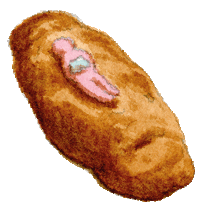cougnou or “bread of Jesus”

Form: Small loaf in shape of baby Jesus, with a little plaster baby Jesus or terra cotta circle as decoration
Country of origin: Belgium
What distinguishes it from other methods of bread making: Decorated Viennese bread
Category of bread: (8 and 10) Festive bread, in the same vein as gingerbread, usually given to children during Christmas
Particularity: The plaster circle used for decoration is referred to as a patacon, and has become a collectors’ item
Ingredients: T45 flour; baker’s yeast; milk; eggs; butter; sugar; raisins; pearl sugar for decoration; patacan

Belgium
The end-of-year celebrations – St. Nicholas, Epiphany and Christmas -- are mainly focused on children and serve as an occasion to rejoice in many ways, especially gastronomically. Children can be invited to help prepare holiday breads, which are traditionally made in Christian countries during this period. Other breads can also be embellished and sweetened to accommodate their taste.
This bread is therefore rich in fat, eggs, and sugar, and fall into the category of Viennese-type breads with a soft crumb, such as brioche; French milk bread, as well as breads for special occasions and gingerbread. All these types of bread are prepared in harmony with the civil and religious holidays, but above all, once they have been kneaded and shaped, they are finely decorated. The cougnu played its cards right, and has truly established itself as a bread with a lot of character.
In olden times, cougnou as Viennese bread with a pink marzipan or plaster figurine of a swaddled baby Jesus. One can’t help associating it to the Christmas crib figures from Provence in the South of France, initially made out of breadcrumbs and used to adorn the Christmas manger. As time went by, the baby Jesus figurine was gradually replaced with small terra cotta or plaster circles, referred to as patacons or patagons (formerly a currency), representing a wide array of painted figures. These patacons have now become collectors’ items, just like the lucky charms hidden in the 12th-night cake, highly sought-after by collectors.

